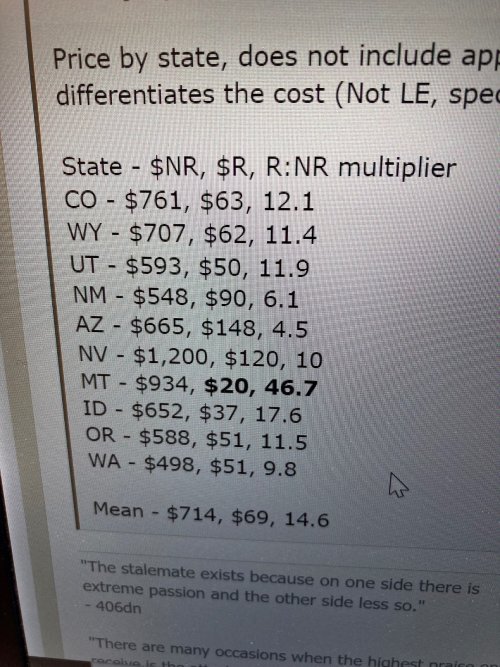You're much more versed in these things than I am so I'm just trying to understand this. I realize I could be way off with my logic so correct me as you see necessary.You wouldn't. You'd essentially be revenue neutral. You'd also likely not sell out, so you could realistically expect a drop in revenue.
NR Antlerless harvest is the largest growth sector for NR's in elk hunting. Moving antlerless harvest to permit on public land helps greatly in terms of dealing with the mass influx of NR hunters and it has the least amount of revenue hit to it. Similarly, when you look at deer licenses, the biggest growth has been in the orphaned deer license and antlerless. FWP is statutorily mandated to sell the orphaned deer licenses (about 7K new B11 combos come from that) but they have taken steps this year to greatly reduce the NR antlerless harvest (and resident too).
The issue relative to elk management is that we've seen a large increase in hunter days and hunters in general (NR & R hunter numbers for deer & elk have both grown), and a decrease in hunter success, which has led to a lot of policy decisions that have further exacerbated the issue of problematic distribution of elk, making those animals unavailable for harvest.
It's awesome that you find a bull every year and I celebrate your success. But you are one of the few. MT success rates for bull elk are currently about 13% and falling, and that number itself can be deceiving as the average number of days it takes to harvest a bull are increasing. Your success is not common. Meanwhile, we are seeing larger distribution issues across the state when it comes to elk leaving public land during archery seasons and concentrating where they know they are safe. This is leading to the increase in herd size and the problems associated with large concentrations of animals that are unavailable to the public hunter.
So as I understand it, most nonresidents are currently waiting 2-3 years to draw a big game combo right? This tells me that demand is far greater than supply. I also am not up to speed on prices and processes in other western states, but I believe Montana is one of the cheaper if not the cheapest option with the best draw odds to hunt elk in, right? Or no? It seams to me that if montana were to double their non-resident prices from $1kish to $2kish, most non-residents would not even blink an eye at the price hike, and the few that decide to opt out would quickly get their spots filled by the next non-residents in line. What am I missing here? I'd like to understand this better.
Last edited:





